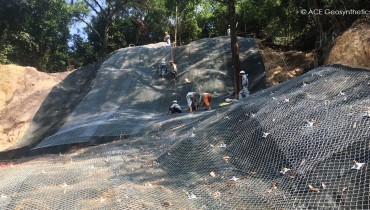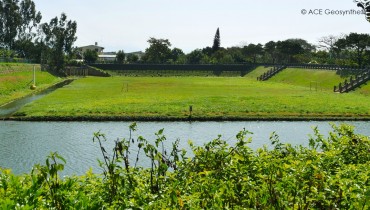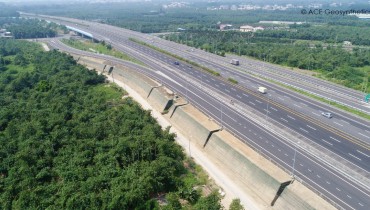News
Special Report-Application of ACETube® in Beach Restoration
In recent years, many coastal facilities or structures must be built because of the needs of various infrastructure constructions and economic developments of human beings for decades, leading to significant changes in the coastal environment. In terms of natural factors such as global warming, sea level rise, typhoons, huge waves, and storm surges also worsens because of the extreme weather. The marine ecological resources are under severe threat, and the coastline has eroded severely. Many coastal protection methods have been derived to prevent the coast from receding and maintain the stability of the coastline.
Traditional coastal protection projects' planning and design considerations include disaster prevention and structural safety. The most commonly applied in coastal protection facilities are reinforced concrete seawalls, revetments, jetties, and offshore breakwaters.
Although these structures can play the role of disaster prevention and wave control, they often have adverse effects on the coast's natural environment, ecology, and aesthetic landscape. In addition, because of design problems, the rigid coastal protection construction method often increases the wave reflection in front of the structures to accelerate beach erosion, causing numerous protests from ecological, environmental protection, and landscape groups. The government's coastline development thus must meet the world trend. It means that apart from the function of homeland security, the built facilities must also meet the multi-functional goals of environmental protection, ecology, and aesthetic landscape.
The planning and design requirements of coastal disaster prevention facilities should not only consider traditional safety, economy, and function but also consider the protection and rehabilitation of the natural ecological environment to achieve the maintenance and sustainable utilization of the coastal environment.
The purpose of coastal protection is mainly to prevent or improve coastal erosion caused by the imbalance between the amount of sand supplied to the coast and the amount of sand discharged. The types of general coastal erosion are broadly classified as follows:
1. Erosion of sea cliffs:
The soft mudstone or sedimentary geological formation near the coast collapsed and eroded because of the long-term wave actions and the surcharge of overburden.
2. Reductions of sediment transport from rivers:
Sediment discharged from rivers is the primary source of drifting sand along the coast. If the amount of sediment transported by the river is much more significant than the erosion of waves, a delta will be formed at the estuary. An accumulation formation will be formed along the coast. However, if the upstream soil loss is reduced due to some factors and causes a lesser amount of sand and gravel to flow downstream, the sharp reduction of the estuary sand source results in the accumulation of the river far less than the wave erosion and thus leading to the formation of coastal erosion.
3. The impact of coastal structures:
If the coastal facilities, such as breakwaters, jetties, and offshore breakwaters, are not properly planned and designed, they may block the sediment transport by ocean currents, reduce the precipitation of drifting sand, and some of the sediment will be carried offshore by rip currents, resulting in coastal erosion.
4. Effect of waves and tidal currents:
The water flow generated by waves and tides drives sand transport along the coast. When the wave steepness is more significant, or the foreshore slope is steep, the backflow speed will increase, which may result in beach erosion.
In recent years, many innovative protective methods have been developed because of the modern technology in the civil engineering industry that can account for coastal characteristics, eco-environment, and aesthetic landscapes—for example, artificial beach nourishment, submerged breakwater, and sand binding fence. Among them, artificial beach nourishment is the most consistent with the principle of nature. The beach is a natural wave absorber. Artificial beach nourishment is a technology that moves suitable particle size of the sand resource to the eroded area through hydraulic or mechanical transportation to balance supply and demand along the coast to achieve stability. Alternatively, it uses engineering solutions to improve or maintain beaches from erosion. It is a non-structural coastal erosion control method to help prevent beaches from erosion. Compared with other anti-erosion methods, the advantages of artificial beach nourishment are:
1. The disturbance to the evolution process of the natural beach is minimal, and it has a positive protection effect on the downstream area of sand transport.
2. It can still maintain the original beach landscape and recreational functions.
3. For long-term considerations, if there is an appropriate sand source, it has better economic benefit.
Beach nourishment requires an analysis of the dominant direction of sand drift, the amount and characteristics of sand to be replenished, and the topographic slope of the beach. In addition, more than beach nourishment is needed to permanently solve the problem of beach line loss. If there is still a trend of soil and sand loss after the nourishment of the beach, it is necessary to continue to supplement the soil and sand to nourish the beach. Alternatively, it can be treated with appropriate artificial structures, such as a jetty, detached breakwater, submerged breakwater, artificial headland, and other facilities.
In recent years, geotextile tube technology has been widely used for coastal protection as temporary or permanent coast structures along with artificial beaches. It functions to slow down the loss of sand and create a coastal space that simultaneously meets the needs of safety, eco-environment, aesthetic landscape, and waterfront amenity.
ACETube® , manufactured by ACE Geosynthetics, are tubular woven bags made of woven high tensile strength polypropylene (PP) with excellent anti-ultraviolet, water permeability, and durability. In recent years, it has been widely used domestically and internationally for various types of waterfront structures (groin, detached breakwater, breakwater, submerged breakwater) in river protection, marine construction, hydraulic facilities, and other related applications. It also can be used for associated services such as temporary cofferdams, coastal protection, artificial dunes, artificial beach nourishment, and other related applications. The following are the successful cases of our company's ACETube® applications for coastal protection:
Case Studies
1. Coastal Protection for Kinmen Airport, Kinmen

Project Descriptions
This project is located at Kinmen Airport, whose runway, runway shoulder, and overrun areas are adjacent to the coast. During the earlier airport's construction, the runway area's coastal part was armored by riprap protection revetment. However, because of the geographical location and the frequent attacks of spring tides, waves, and heavy rains accompanied by typhoons and flood seasons in recent years, the runway area foundation has been washed away severely. Part of the seawalls or slopes thus has been damaged by seawater, forming deep gullies and gaps, which have endangered the safety of the runway and are in urgent need of improvement and repair.
The riprap revetment initially designed on the seaside has lost its protective function because of the wave attack and the long-term scouring of the revetment foundation, destroying the riprap revetment structure. After evaluation, the designer planned to use ACETube® to protect the toe of the revetment from resisting wave impact and reducing erosion.
The first step of the construction was to lay ACETube® and the geotextile separator in front of the toe of the proposed riprap revetment, and then the new riprap revetment was constructed toward the airport runway. Finally, a concrete gravity wall was built on top of the revetment adjacent to the overrun areas to enhance the protection function of the revetment further.
The primary function of the installed ACETube® was to resist the wave impact on the toe of the revetment and avoid the retreating shoreline's effect on the runway's safety. ACETube® was designed based on stress analysis to account for the requirements for service durability and ultimate stress conditions at the site. As shown in Figure 1, the circumference of the placed ACETube® was 13m with a total length of 1,868m. It was fabricated using ACETex®, a PP woven geotextile with a two-way strength of 175x175 kN/m.

Figure 1.1 Schematic diagram of the ACETube® at Kinmen Airport
Features
Two years after the completion of the project, observations at the site have shown that ACETube® effectively eliminated the damage at the toe of the revetment, as shown in Figure 1.2. The area near the shoreline behind ACETube® has developed dunes indicating ACETube® has substantially improved beach nourishment, sand fixation, and sand storage.
 |
 |
Figure 1.2 Before & after the application of ACETube®

2. Tidal Inlet Restoration of Sandbar, Tainan, Taiwan

Project Descriptions
This project is located on the sandbar of Wangye Harbor, Beimen District, Tainan City. A tidal inlet progressively developed due to wind and waves had caused the resisting function of natural sandbar for spring tides to disappear, which posed a severe threat to the fishery industry of inland lagoon fishermen. Therefore, it is in urgent need of remediation.
In the early years, the authority used bamboo piles and cubical sandbags to fix sand. Although they had specific positive effects in some areas, they did not effectively repair the tidal inlet area because of adverse oceanographic phenomena. According to satellite image analysis, the most severely eroded sandbar of Qingshan Harbor in Cigu District has retreated an average of 50m per year over the past two decades.
The restoration of tidal inlet must first overcome the challenges of turbulent ocean currents. Secondly, the impact of project feasibility, overall economy, eco-environment, and sustainable carbon reduction of the overall project also should be considered. After multi-scheme evaluations, the project adopted the ACETube® as the repair solution. ACETube® can be custom-made by selecting the appropriate dimensions according to the site conditions. It can be quickly constructed and achieve short-term restoration for the damaged tidal inlet. The total length of the ACETube® was about 420 m, as shown in Figure 2.1. The in-situ sea sand was pumped into the ACETube® to construct a three-layer stacked structure. Bamboo piles were driven on both sides of the ACETube® to provide protection and fixation.

Figure 2.1 Schematic diagram of ACETube® for Wangyegang Sandbar, Beimen District
Features
Over the past years, the constructed ACETube® has experienced the attacks of waves and swells as large as 10 meters brought by strong typhoons after the completion of this project, yet the overall structure was stable, and the effect of sand trapping also was remarkable. From 2003 to 2012, the rate of shoreline retreat had significantly reduced to 6 m per year. By comparing the changes from 2012 to 2020, the shoreline has shown a stable trend, proving that the sandbar restoration has achieved the initial target for the goal of sandbar restoration and sustainable development of the lagoon.
The overall engineering planning of this project was conducted based on the principle of using local materials, which conform to the standard of natural-like engineering method and achieve carbon reduction. The construction of using natural bamboo piles combined with ACETube® not only served as temporary fixings to protect both sides of the ACETube® but also increased the effect of sand trapping and stabilizing for the overall project. In addition, this project used many in-situ natural materials for construction, avoiding using rigid reinforced concrete structures. Such considerations have achieved the maximum possibility of reducing the effect and impact of engineering facilities on the overall eco-environment.
3. Beach Nourishment, Qijin Windmill Park, Kaohsiung, Taiwan

Project Descriptions
In the past, the beach area along Qijin Coast in Kaohsiung has been reduced yearly because of wave erosion. In addition, the expansion of Kaohsiung Harbor, the construction of the South Star Project, the development of the Intercontinental Container Terminal, and other related factors caused the replenishment of coastal sand sources to be reduced, resulting in increased coastal erosion. The investigations showed that the coastline has receded by nearly 100m in the past decade. In 2011, the authority constructed an offshore submerged breakwater with precast concrete armor blocks to reduce the wave and velocity. In addition, sand was pumped from the sea to replenish the severely lost Qijin beach through artificial beach nourishment, but the effect was worse than expected. Although the erosion of the shoreline has been slowed down, the beach was not fully restored successfully.
As shown in Figure 3.1, based on multi-scheme evaluations, the designer applied ACETube® parallel to the existing submerged breakwater to improve its original design function of restoring the beach. Such an arrangement developed a cofferdam-like area, preferably as a sand trap to store the sand pumped from the sea. After the completion of the filling, the ACETube® and the sand trap zone thus can effectively prevent and protect the coastal seabed scouring. The direction of coast drifting sand from south to north also has favored the beach nourishment completed effectively in a short period.

Figure 3.1 Schematic diagram of the ACETube® in Qijin Windmill Park, Kaohsiung
Features
The actual amount of hydraulic sand backfill in this project was 13,600 m3. The monitoring result of the backfilled area has indicated that, after two months of the completion, no loss of sand was observed at the site. ACETube® also has been almost covered by sand. In addition, approximately 17,500 m3 of sand has been recovered from the beach outside the ACETube®, showing remarkable results for beach nourishment (Figure 3.2).

Figure 3.2 The construction effect of the ACETube® in Qijin Windmill Park

Conclusion
Coastal erosion and coastline retreat have caused an increasingly severe land loss problem. Because of the need for national constructions to follow the world trend, the planning and design of coastal protection projects must satisfy the function of national security and meet the multi-functional objectives of environmental protection, ecology, and aesthetic landscape. Traditional protection methods for construction have been unable to improve and meet the above requirements. Only innovative techniques and materials with green thinking can complete the project construction objectives of energy saving, carbon reduction, and sustainable development.
Based on the three case studies presented above, ACETube® can be successfully applied for coastal revetment, tidal inlet restoration, and artificial beach nourishment. Because of the situations in which the traditional coastal protection method cannot correctly achieve the purpose of protection, the application of ACETube® can successfully improve the objective that the original design cannot reach. In addition, the use of ACETube® only acquires in-situ materials and eliminates the need for reinforced concrete structure. Its construction has reduced the impact on the overall ecological environment and natural landscape to the greatest extent possible. It fully meets the objectives of net zero emission of energy saving, carbon reduction, and sustainable development required by national constructions in recent years. It is worthy of further promotion and application.
Similar News

Safeguarding for Shallow Slope Sliding: A Sustainable Slope Stabilization Project
TOP STORY Shallow Landslide Treatment Project, Ba Deo Park, Ha Long City, Vietnam Backgr...

Innovative Flood Management: Detention Pond with Flood Control and Recreational Design
Detention Pond with Reinforced Earth Dike for Fazi River, Taichung, Taiwan Background In recen...

Reinforcement of the Slope at the Entrance Ramp of Interchange on National Freeway, Taiwan
"TOP STORY" In Taiwan, an island nation, freeways play a pivotal role in facilitating...